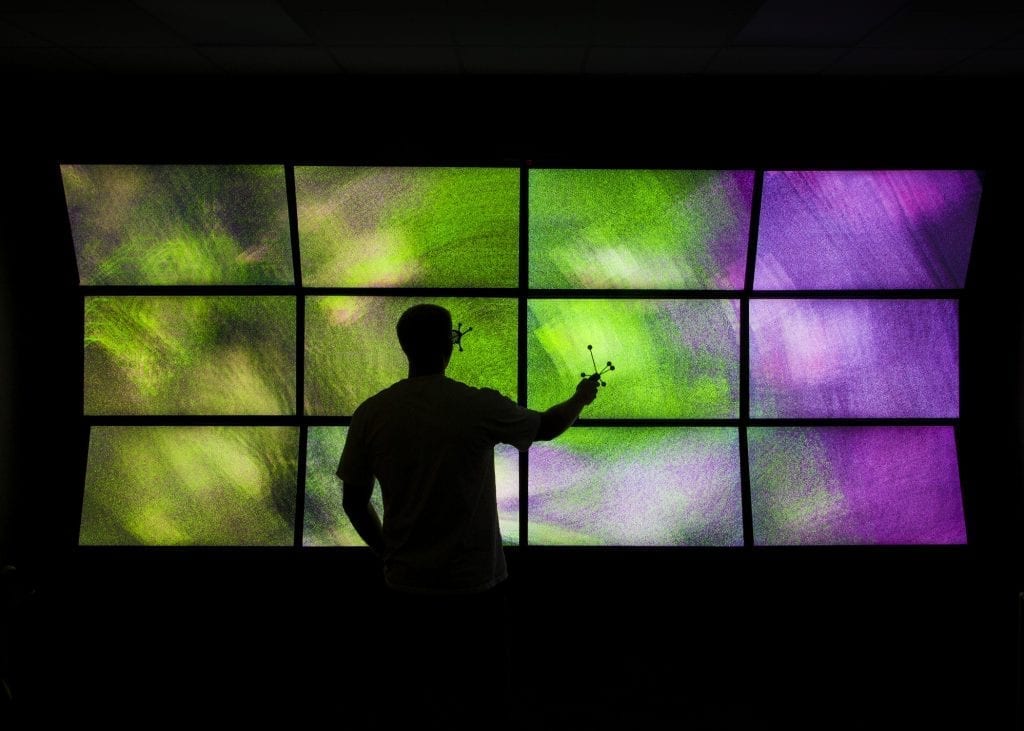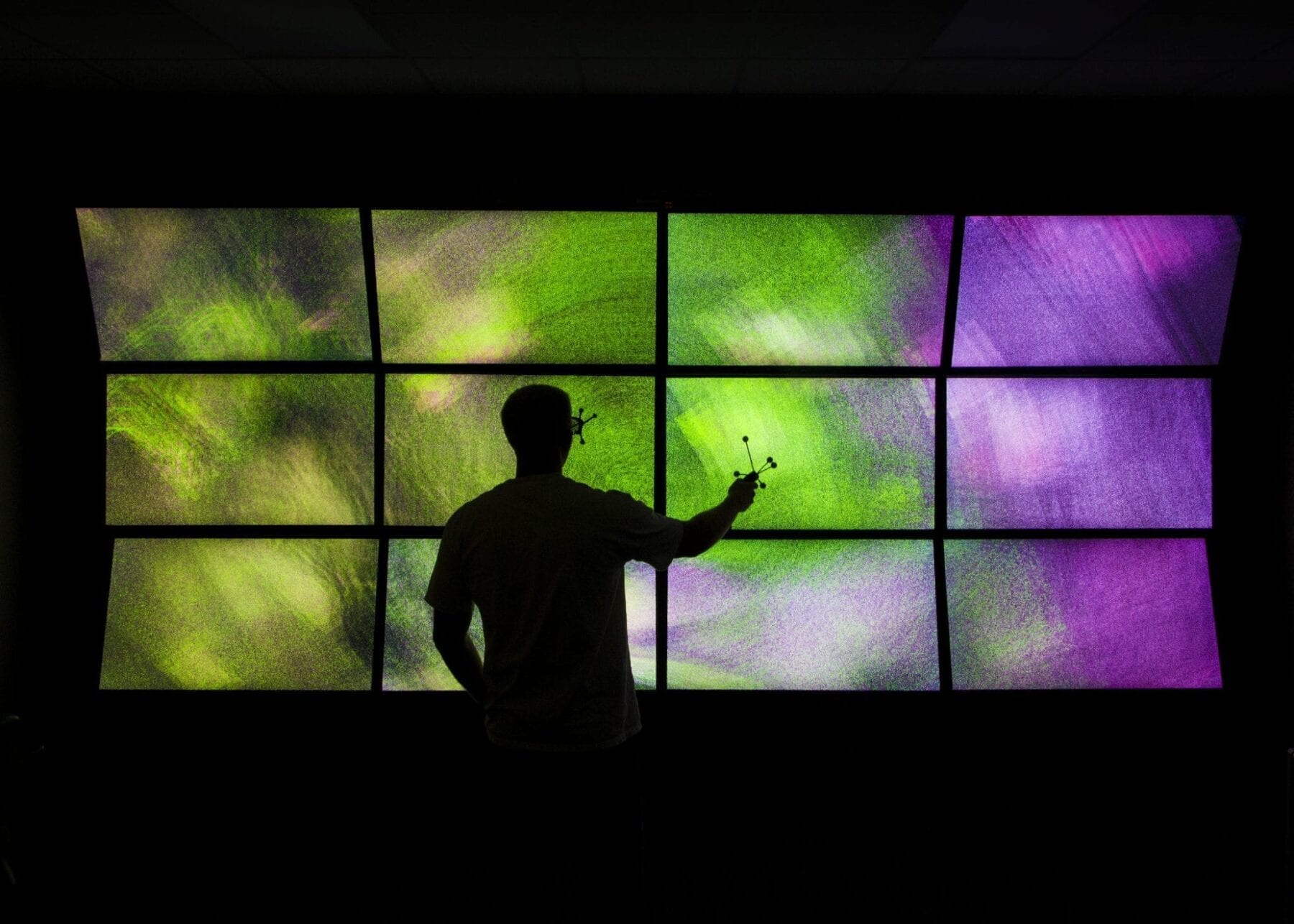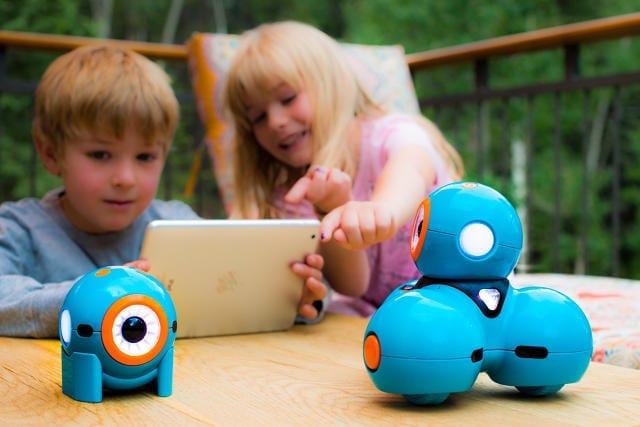
VuePod lab. Dr Daniel Ames, Civil and Environmental Engineering.
3D imaging research.
Jossie Bastian freshman in CEE
BYU’s 3D virtual reality system much cheaper, just as effective as others
It’s like a scene from a gamer’s wildest dreams: 12 high-definition, 55-inch 3D televisions all connected to a computer capable of supporting high-end, graphics-intensive gaming.
On the massive screen, images are controlled by a Wii remote that interacts with a Kinnect-like Bluetooth device (called SmartTrack), while 3D glasses worn by the user create dizzying added dimensions.
But this real-life, computer-powered mega TV is not for gaming. It’s for engineering.
Welcome to Brigham Young University’s VuePod, a 3D immersive visualization environment run by BYU’s Department of Civil and Environmental Engineering. Student-built and operated, under the supervision of civil engineering professor Dan Ames, the VuePod is changing the way engineers are viewing environmental engineering challenges.
“This is gold,” said fellow BYU civil engineering professor Kevin Franke. “This technology has the ability to revolutionize my job as an earthquake engineer.”
That’s because the VuePod allows users to virtually fly over, wander through or hover above 3D environments that are otherwise difficult to visit. The images are created by point data from aircraft equipped with LIDAR (think RADAR, but with lasers). The LIDAR scans the landscape and records millions of data points that are then viewed as an image on the VuePod. Point data can also be created from stitched-together photographs taken from low-cost drones, which is Franke’s research focus.
One set of data currently available for study in the VuePod captured a canyon area beneath a plateau in southern Idaho. With 3D glasses and the Wii controller, a user can virtually drop down into the canyon from above, and then fly from one end to the other.
As cool as it is to fly through a canyon, the real engineering application comes in when you combine two sets of data for the same canyon, taken five years a part. With the second set of data, changes in the natural landscape that are invisible to the human eye become clear as day. Thanks to the VuePod’s massive 108-square-foot screen, all of the image-making data can be presented for viewing.
“Our eyes and our brains are so amazing; we need to take full advantage of them,” Ames said. “That’s the value of this project: we’re presenting more information for the human eyes to detect changes.”
Read more: 3-D virtual reality system: Holodeck Getting Closer?
The Latest on: 3-D virtual reality system
[google_news title=”” keyword=”3-D virtual reality system” num_posts=”10″ blurb_length=”0″ show_thumb=”left”]
via Google News
The Latest on: 3-D virtual reality system
- Veterans: Virtual reality is veteran’s path to recoveryon April 27, 2024 at 5:20 pm
It was my first time using virtual reality. There was a dichotomy in my brain between ‘I am perfectly fine and I am freaking out’ and ‘I am perfectly fine’ ...
- Nobody Wants This AI Bloatwareon April 26, 2024 at 1:00 pm
AI has the potential to change our lives, for better or for worse. But just because AI is the latest trend in tech, that doesn't mean tech companies need to force it into all of their products.
- What the heck happened to CDMA networks?on April 26, 2024 at 11:08 am
GSM and CDMA introduced digital transmission for both voice and data, and with it came enhanced privacy. Primarily through unique encoding for each call, and spreading phone calls across the entire ...
- Inside the virtual reality software LSU's Jayden Daniels used to help become a top NFL pickon April 25, 2024 at 3:05 am
LSU quarterback Jayden Daniels used a virtual reality software created by a German company to help him improve.
- Meta's Reality Labs posts $3.85 billion loss in first quarteron April 24, 2024 at 1:27 pm
Mark Zuckerberg's bet on the metaverse continues to be a money-bleeding endeavor, with the unit reporting billions of dollars in losses every quarter.
- Meta opens its mixed-reality Horizon OS to other headset makerson April 24, 2024 at 12:13 pm
Lenovo and Asus are among the companies building headsets that run Horizon software. The move expands Meta’s reach in the AR/VR market, while enabling headset vendors to focus on hardware development ...
- Mark Zuckerberg says Meta will offer its virtual reality OS to hardware companies, creating iPhone versus Android dynamicon April 22, 2024 at 11:16 am
The move will create new hardware devices that run the same operating system and software as Quest 3 and Quest Pro.
- PhysDreamer Study Reveals Breakthrough in Video Generation for Dynamic 3D Object Interactionson April 22, 2024 at 2:25 am
PhysDreamer is setting a new standard in virtual reality by enabling dynamic, physics-based interactions for 3D objects in video generation ...
- Netflix’s ‘3 Body Problem’ is a solid adaptation of the books. But it could use some religion.on April 19, 2024 at 10:40 am
"3 Body Problem" is an imaginative Netflix adaptation of Cixin Liu's trilogy of sci-fi novels—and yet is mostly true to the books.
- VXR at VA: Virtual reality demo reveals potential to treat veterans with anxiety, depressionon April 18, 2024 at 6:15 pm
VA Immersive, a sector within the Veterans Affairs Office of Healthcare Innovation and Learning, put on a demonstration of virtual reality and augmented reality technology called Veteran Experience ...
via Bing News











